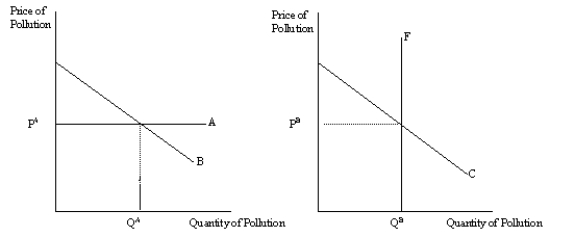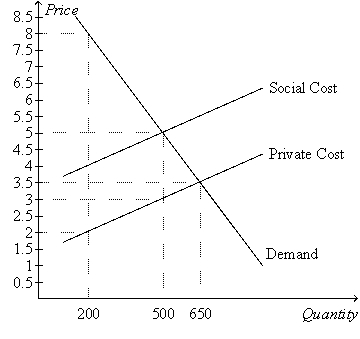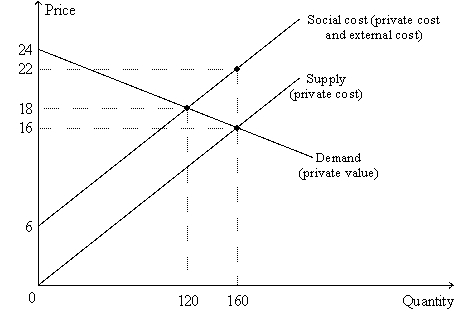A) traffic congestion.
B) traffic accidents.
C) air pollution.
D) EPA regulations.
F) A) and C)
Correct Answer

verified
Correct Answer
verified
Multiple Choice
Patents do not
A) provide firms an incentive to research.
B) assign property rights to inventors.
C) protect the rights of inventors for their lifetimes.
D) internalize externalities.
F) A) and C)
Correct Answer

verified
Correct Answer
verified
Multiple Choice
A patent is used to
A) disseminate information.
B) offset the negative effects of taxes.
C) protect inventors for as long as they live.
D) assign property rights.
F) A) and D)
Correct Answer

verified
Correct Answer
verified
Multiple Choice
One drawback to industrial policy is that
A) technology spillovers are too expensive to control.
B) measuring the size of spillovers from different markets is difficult.
C) spillovers often occur in industries that produce undesirable products for society.
D) positive side effects are often outweighed by negative side effects.
F) A) and D)
Correct Answer

verified
Correct Answer
verified
Multiple Choice
Tradable pollution permits
A) have prices that are set by the government.
B) will be more valuable to firms that can reduce pollution only at high costs.
C) are likely to create a higher level of total pollution.
D) are less desirable than corrective taxes in reducing pollution.
F) None of the above
Correct Answer

verified
Correct Answer
verified
Multiple Choice
Figure 10-15  -Refer to Figure 10-15.Which of the following is not necessary in order for the corrective tax and pollution permit to have equivalent effects?
-Refer to Figure 10-15.Which of the following is not necessary in order for the corrective tax and pollution permit to have equivalent effects?
A) PB must be equivalent to the corrective tax.
B) QA must be equivalent to the amount of pollution allowed to the pollution permit holders.
C) The equilibrium price and quantity of pollution must be the same in both graphs.
D) The amount of pollution emitted by each firm must be the same.
F) A) and C)
Correct Answer

verified
Correct Answer
verified
Multiple Choice
Figure 10-2.The graph depicts the market for plastic.  -Refer to Figure 10-2.Suppose that the production of plastic creates a social cost which is depicted in the graph above.Without any government regulation,how much plastic will be produced?
-Refer to Figure 10-2.Suppose that the production of plastic creates a social cost which is depicted in the graph above.Without any government regulation,how much plastic will be produced?
A) 200
B) 500
C) 650
D) 900
F) All of the above
Correct Answer

verified
Correct Answer
verified
True/False
A corrective tax places a price on the right to pollute.
B) False
Correct Answer

verified
Correct Answer
verified
Multiple Choice
When the government uses a command-and-control policy to solve an externality,it
A) is usually the most effective policy option available.
B) creates policies that directly regulate behavior.
C) usually involves taxing the consumption of a commodity.
D) typically refers to the Coase theorem to structure the policy.
F) A) and B)
Correct Answer

verified
Correct Answer
verified
Multiple Choice
With pollution permits,the supply curve for pollution rights is
A) perfectly elastic.
B) perfectly inelastic.
C) upward sloping.
D) downward sloping.
F) A) and B)
Correct Answer

verified
Correct Answer
verified
Multiple Choice
Positive externalities
A) result in a larger than efficient equilibrium quantity.
B) result in smaller than efficient equilibrium quantity.
C) result in an efficient equilibrium quantity.
D) can be internalized with a corrective tax.
F) B) and D)
Correct Answer

verified
Correct Answer
verified
Multiple Choice
Which of the following is NOT a way of internalizing technology spillovers?
A) subsidies
B) patent protection
C) industrial policy
D) taxes
F) A) and B)
Correct Answer

verified
Correct Answer
verified
Multiple Choice
Assume that your roommate is very messy.Suppose she gets a $25 benefit from being messy but imposes a $50 cost on you.The Coase theorem would suggest that an efficient solution would be for you to
A) pay your roommate at least $25 but no more than $50 to clean up after herself.
B) pay your roommate at least $51 to clean up after herself.
C) charge your roommate at least $25 to have you clean up after her.
D) charge your roommate at least $50 but no more than $100 to keep you from complaining about the mess.
F) A) and D)
Correct Answer

verified
Correct Answer
verified
Multiple Choice
Since air pollution creates a negative externality,
A) social welfare will be enhanced when some,but not all air pollution is eliminated.
B) social welfare is optimal when all air pollution is eliminated.
C) governments should encourage private firms to consider only private costs.
D) the free market result maximizes social welfare.
F) All of the above
Correct Answer

verified
Correct Answer
verified
Multiple Choice
Emission controls on automobiles are an example of a
A) corrective tax.
B) command-and-control policy to increase social efficiency.
C) policy that reduces pollution by allocating resources through market mechanisms.
D) policy to reduce congestion on urban freeways.
F) B) and D)
Correct Answer

verified
Correct Answer
verified
Multiple Choice
Suppose that alcohol consumption creates a negative externality.What can the government do to equate the equilibrium quantity of alcohol and the socially optimal quantity of alcohol?
A) impose a tax on alcohol that is equal to the per-unit externality
B) offer a subsidy on alcohol that is equal to the per-unit externality
C) impose a regulation limiting the amount of alcohol that each consumer can purchase
D) nothing
F) A) and C)
Correct Answer

verified
Correct Answer
verified
True/False
According to the Coase Theorem,individuals can always work out a mutually beneficial agreement to solve the problems of externalities even when high transaction costs are involved.
B) False
Correct Answer

verified
Correct Answer
verified
Multiple Choice
When an industry is characterized by technology spillover,what should the government do to ensure that the market equilibrium equals the socially optimal equilibrium?
A) Impose a tax greater than the value of the technology spillover.
B) Not allow production of any product that causes a technology spillover.
C) Provide a subsidy equal to the value of the technology spillover.
D) Require producers to "clean up" any spillover that results from their production process.
F) A) and C)
Correct Answer

verified
Correct Answer
verified
Multiple Choice
Figure 10-10  -Refer to Figure 10-10.Taking into account private and external costs,the maximum total surplus that can be achieved in this market is
-Refer to Figure 10-10.Taking into account private and external costs,the maximum total surplus that can be achieved in this market is
A) $760.
B) $1,080.
C) $1,440.
D) $1,920.
F) A) and D)
Correct Answer

verified
Correct Answer
verified
Multiple Choice
Most economists prefer corrective taxes to regulation to correct the pollution problem because:
A) the market-based solution is less costly to society.
B) the market-based solution can result in a greater reduction in pollution.
C) the market-based solution raises revenue for the government.
D) all of the above.
F) All of the above
Correct Answer

verified
Correct Answer
verified
Showing 181 - 200 of 439
Related Exams